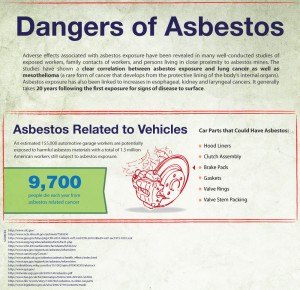Most people choose carbon monoxide from exhaust fumes when asked to name a deadly chemical from their automobile. There are many more substances that are just as toxic found inside the vehicle. These are a few of those hidden dangers.
Older cars have some parts that contain asbestos. The production of automobile parts used asbestos for many decades. Possible asbestos may be found in brake pads, hood liners, gaskets, valve rings, valve stem packing, and clutch assembly materials. Exposure to asbestos brings the risk of lung cancer or mesothelioma.
 Many people love the smell of a new car. That smell is from the textiles and plastics used in automobile interiors. Unfortunately, it is full of potentially harmful chemicals, including bromine, lead, and the carcinogen benzene.
Many people love the smell of a new car. That smell is from the textiles and plastics used in automobile interiors. Unfortunately, it is full of potentially harmful chemicals, including bromine, lead, and the carcinogen benzene.
Glove boxes contain chlorine, making it a source for airborne toxins known as phthalates. Phthalates make the plastics in automobile interiors softer. The amount of toxins will grow in the summer months, when the sun heats the plastics. The inside of a vehicle has the potential to heat up to 190 degrees. The fumes produced leave a film on the inside of the windshield. It is also possible that the film may occur in the lungs.
Many cars contain the common brominated flame retardant of decabromodiphenyl ether. It is in dashboards, steering wheels, headlining, and seat materials. This chemical also leaves a film on the inside of the windshield.
Chemicals reside in armrests, wire insulation, and floor coverings. These all contribute to the new car smell and the creation of car dust and air pollutants. Occupants inside the vehicle gain exposure to these chemicals by having direct contact with the car dust and through inhalation.
Automobile manufacturers are working to phase out the use of toxic chemicals. This is a difficult task, as there is a risk of lowering the fire safety of a vehicle without the use of chemicals. Many groups are calling for tougher regulations regarding the use of these toxins.
There are steps vehicle owners can take to reduce the release of chemicals in their cars. Solar reflectors will help to reduce UV exposure, as it causes the chemicals in flame-retardants to become extremely dangerous. Venting the interior as much as possible will air out some of the fumes. Parking in the shade will help to keep the interior temperature down.
There is starting to be some public awareness of the potential dangers in an automobile. Cars emit pollutants, both inside and out. Drastic measures must be taken to correct these issues. Until then, vehicle owners must take action on their own to reduce health risks.